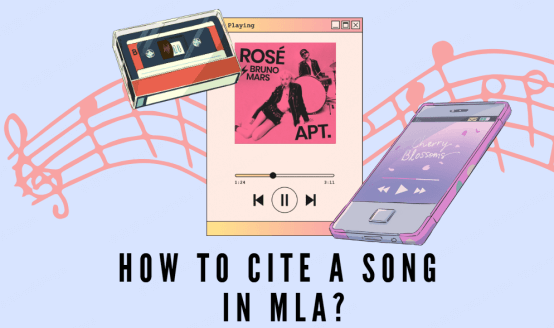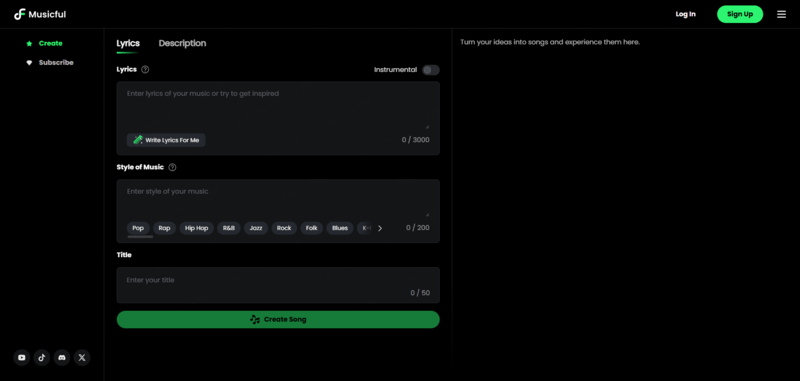May 13, 2025
5 min read
Understanding how to cite a song in MLA format is crucial for students and researchers who need to reference music in academic papers. Proper citation helps give credit to artists and aligns your work with academic standards, whether you're citing song lyrics or entire tracks.

For those asking how do you cite a song in MLA, this guide covers all the essentials. We'll learn the key components of an MLA song citation, provide step-by-step instructions. Plus, we'll introduce some citation tools that will make your job easier!

- 1. MLA Works Cited Format for Songs
- 2. MLA In-Text (Parenthetical) Citation for Songs
- 3. How to Cite Song Lyrics from Websites in MLA
- 4. Special MLA Cases: Live, Remix, Instrumental, Original Songs
Part 1: Core Components of an MLA Song Citation
When referencing a song in MLA style, it's important to understand the main parts of the citation. A proper song citation includes the following:
1. Author(s): This is the artist or creator of the song. If there’s a featured artist, both should be listed.
2. Title of the Song: The title should be in quotation marks.
3. Album Title: The album the song belongs to should be italicized.
4. Publisher: The company or platform that released the song.
5. Date of Release: The year the song was released.
6. Format or Medium: Whether it's a digital file, CD, vinyl, etc.
If you understand these parts, you can make sure your citation is complete and follows MLA rules.
Part 2: How to Cite a Song in MLA Format (Step-by-Step)
Citing a song in MLA format requires attention to detail, as each element—artist, title, album, and source—plays a role in creating an accurate citation. Let's check:
1. MLA Works Cited Format for Songs
When creating a Works Cited entry for a song in MLA format, it should follow this basic structure:
Format:
Last Name, First Name(s). "Title of Song." Title of Album, other contributors, Version, Publisher, Year of Release.
⭐ Example: Lamar, Kendrick. "HUMBLE." DAMN., Aftermath Entertainment, 2017.
Make sure to adjust the format depending on the song's specifics—whether it's a single, remix, or live version.
2. MLA In-Text (Parenthetical) Citation for Songs
In-text citations for songs are simpler. All you need to do is include the artist's last name and the time frame (if relevant) in brackets.
Format:
(Last Name, Time).
⭐ Example: (Lamar 00:45-01:05).
This helps readers locate the exact portion of the song you're referencing.
3. How to Cite Song Lyrics from Websites in MLA
If you use lyrics from a website, you need to include the website name and the URL. Here's how you structure it:
Format:
Last Name, First Name(s). "Title of Song." Title of Website, Publisher, Date of Publication, URL.
⭐ Example: Swift, Taylor. "Love Story." Genius, Genius Media Group, 2021, www.genius.com/Taylor-Swift-love-story-lyrics.
4. Special MLA Cases: Live, Remix, Instrumental, Original Songs
When citing live versions, remixes, instrumental versions, or original compositions, you may need to change how you cite it to match these different cases:
● Live Performances: Include the location of the performance if possible.
⭐ Example: Lamar, Kendrick. "HUMBLE." Live at the MTV Music Awards, MTV, 2017.
● Remixes and Instrumentals: Cite the original song and indicate the version you're referencing.
⭐ Example: Lamar, Kendrick. "HUMBLE" (Remix). DAMN., Aftermath Entertainment, 2017.
● Original Songs(Including AI-Generated Music): If you are quoting a song that you wrote yourself or that was made using an AI music tool, you should still follow MLA format. This means that you need to list the creator (or platform), the title of the song, the platform where it was published, the year, and the URL.
● Original Songs(Including AI-Generated Music): If you are quoting a song that you wrote yourself or that was made using an AI music tool, you should still follow MLA format. This means that you need to list the creator (or platform), the title of the song, the platform where it was published, the year, and the URL.
For example, the following rap was generated using Musicful, an AI music creator:
⭐ Example: Musicful.ai. "Thanos" Musicful, 2025, www.musicful.ai/song/41116690789523462.
Tips: Musicful is an AI music generator that allows users to create original songs with just a few clicks. It's perfect for users who want to compose unique tracks—complete with melodies, lyrics, and even vocal styles. If you use music that you have made using tools like this, be sure to include the right information in your citation.

Part 3: Using MLA Citation Generators for Songs
Manually formatting MLA citations can take a long time, especially when you're dealing with lots of sources or special song formats like remixes or live versions. That's where tools that generate citations can help.
One useful tool for students is the Chegg MLA Song Citation Generator. This online tool helps you quickly and accurately cite songs in MLA style, whether you're referencing a Spotify track, a YouTube performance, or an AI-generated song.
Site: https://www.chegg.com/writing/features/mla-citation-generator/mla-song-citation

How to use the Song Citation Generator?
Step1️⃣. Visit the Chegg MLA Song Citation Tool.
Step2️⃣. Choose the source type (e.g., song, album, online audio).
Step3️⃣. Fill in the required information (artist name, song title, album, year, URL, etc.).
Step4️⃣. Copy the MLA-formatted citation into your Works Cited page.
Part 4: FAQs About Citing a Song in MLA Format
1. How to cite a song in MLA format?
To cite a song in MLA format, include the artist's name, the song title in quotation marks, the album title in italics, the publisher, the release year, and (if applicable) the URL.
2. How do you cite audio in MLA?
For audio files, such as interviews, podcasts, or spoken-word tracks, the format is similar to a song citation. Include the name of the speaker, the title of the recording in quotation marks, the publisher, and the release year. If you accessed it online, include the URL.
⭐ Example: Swift, Taylor. "Shake It Off." 1989, Big Machine Records, 2014.
For songs on streaming services, include the URL:
⭐ Example: Eilish, Billie. "Bad Guy." WHEN WE ALL FALL ASLEEP, WHERE DO WE GO?, Spotify, https://open.spotify.com/track/2Fxmhks0bxGSBdJ92vM42m?si=2e878916fef74243.
3. How do you cite the song of myself in MLA?
If you're referring to citing a song that you personally wrote in MLA format, you would follow the general format for citing a song but include yourself as the artist.
⭐ Example: Your Last Name, Your First Name. "Song Title." Album Title (if applicable), Year of Composition.
If the song is unpublished or not publicly available (for example, if it's a personal composition or part of a class project), you might add "[Unpublished song]" after the title for clarity:
⭐ Example for Unpublished Song: Smith, Jordan. "Sunrise Dreams" [Unpublished song], 2023.
Conclusion
Using song titles in MLA format doesn't have to be difficult. If you understand what a citation is and know how to deal with special cases like live versions, remixes, or AI-generated songs, you can make sure your work is properly sourced and professional. Tools like Chegg's MLA Song Citation Generator make the process even easier. They save you time and help you avoid common formatting mistakes.
And if you're writing your own songs, whether for school projects, content creation, or just for fun, why not use an AI tool like Musicful? It lets you make full songs with lyrics, melodies and vocals in seconds. Once you've finished your essay, you can use the MLA examples in this guide to cite it properly.


